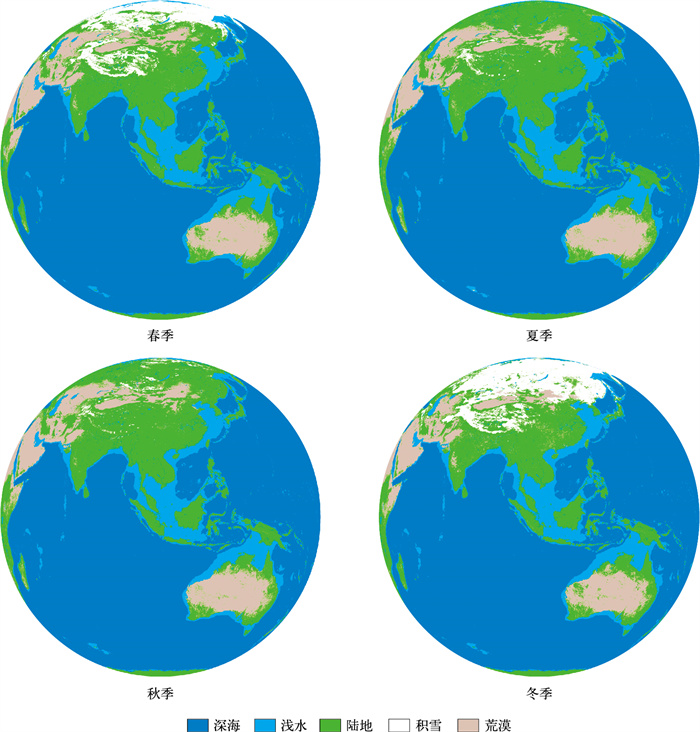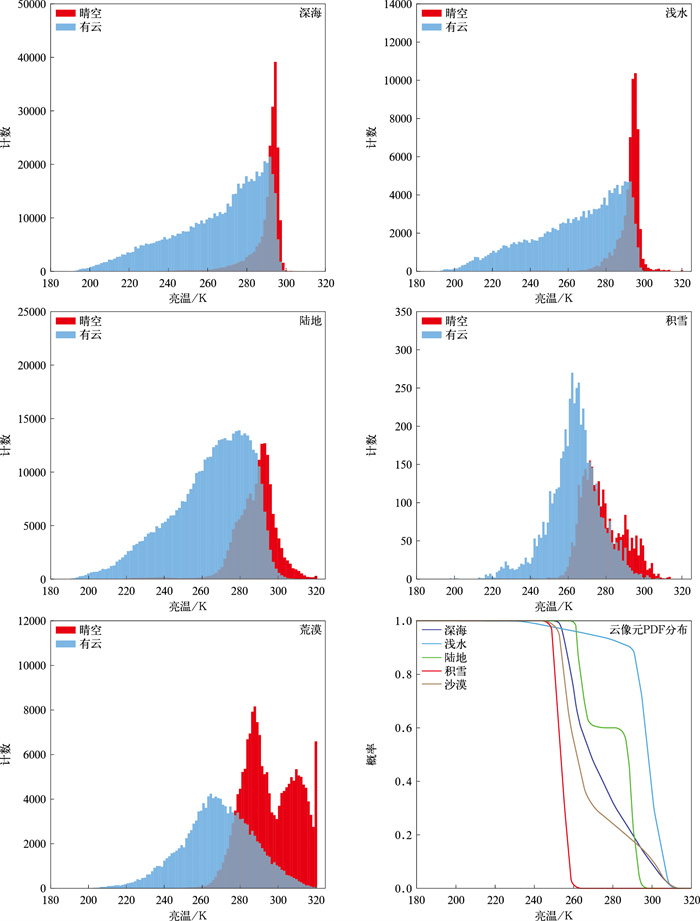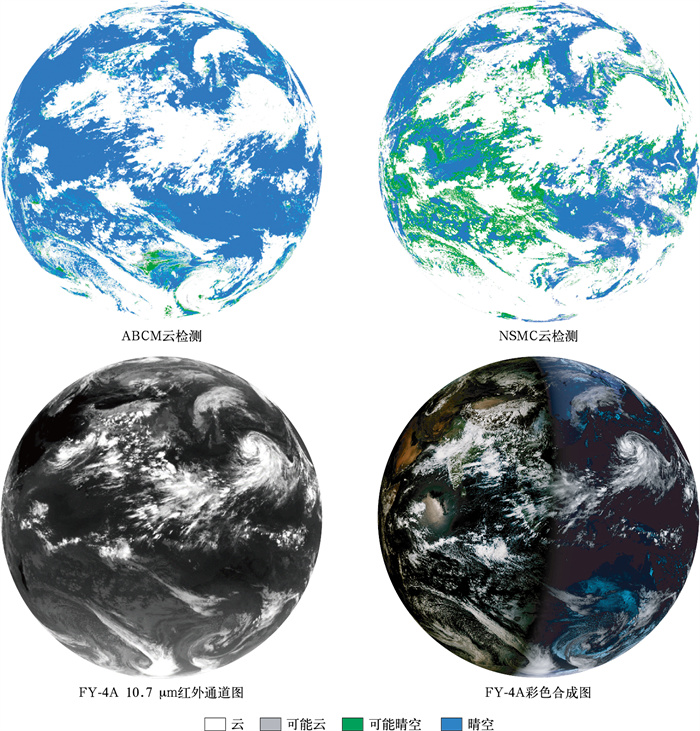FY-4A/AGRI Cloud Detection Method Based on Naive Bayesian Algorithm
-
摘要: 光学遥感云检测是定量遥感和遥感应用的基础, 尝试将朴素贝叶斯的机器学习方法应用于风云四号气象卫星A星(FY-4A)搭载的先进静止轨道辐射成像仪(AGRI)红外通道数据云检测。因辐射物理方法的云检测采用可见光通道导致存在日夜不连续现象,仅选取FY-4A/AGRI载荷7个红外通道的光谱数据,构建10种特征分类,利用正交偏振云-气溶胶激光雷达(CALIOP)与FY-4A/AGRI时空匹配数据,对不同地表类型和不同季节的数据集进行分类训练和验证。与CALIOP数据交叉验证显示除积雪上空云识别准确率约为81%,深海、浅水、陆地和荒漠上空的云识别准确率均高于92%,误判率基本低于10%,总体云识别精度达到90%;与2021年10月和2022年1,4,7月MODIS 2级云检测产品比对,深海、浅水云识别准确率均在88%以上,误判率分别低于3%和10%,夏季云识别效果最佳,总体云识别准确率高达90%。云检测结果不仅得到云、可能云、可能晴空和晴空4种分类结果,还得到每种特征和综合特征云检测分类器的不确定性概率值,这为云和地表相关检测产品提供重要参考。
-
关键词:
- FY-4A/AGRI;
- 朴素贝叶斯;
- 云检测
Abstract: Optical remote sensing cloud detection is the foundation for subsequent quantitative remote sensing and applications. A cloud detection method based on naive Bayesian algorithm is studied and applied to the advanced geostationary orbital radioimager (AGRI) on Fengyun-4A satellite. Cloud detection method considering radiation physics of visible light channels is discontinuous between day and night. To avoid the direct impact of solar radiation, the spectral data of 7 infrared channels loaded by AGRI are analyzed to construct 10 cloud detection feature classifiers. Using cloud polarized lidar with orthogonal polarization (CALIOP) data as the true value of cloud detection, and using its spatiotemporal matching data with AGRI, classification training and validation are conducted for datasets of different surface types and different seasons. The cloud detection results and CALIOP data cross-verification show that the cloud recognition accuracy over snow is about 81%, the cloud recognition accuracy rate over the deep sea, shallow water, land and desert is higher than 92%, the false positive rate is basically less than 10%, and the overall cloud recognition accuracy reaches 90%. Compared with MODIS level 2 cloud detection products in October of 2021 and January, April and July of 2022, the recognition accuracy rate of deep-sea and shallow water clouds is above 88%, and the false positive rate is lower than 3% and 10%, respectively. The overall cloud recognition accuracy rate in four seasons is more than 86%, of which the summer cloud recognition effect is the best, and the overall cloud recognition accuracy rate is as high as 90%. The recognition effects of the method are good during both day and night, ensuring not only the accuracy of day and night cloud detection, but also the continuity of cloud detection in the morning and evening transition zone. Due to the use of dynamic surface type files and sufficient training sample sizes for deep and shallow waters, the overall cloud recognition accuracy of the method is relatively ideal in four seasons, with the best performance in summer and autumn. The cloud recognition accuracy of deep and shallow water is generally high, but there are still omissions and misjudgments. The method can output classification results of cloud including probable cloud, probable clear sky, and clear sky, and it also outputs the uncertainty probability value of each feature and a comprehensive feature cloud detection classifier, which can provide important reference for cloud and surface related detection products.-
Key words:
- FY-4A/AGRI;
- naive Bayesian algorithm;
- cloud detection
-
表 1 2021年1月FY-A/AGRI与CALIOP比对
Table 1 Evaluated parameters of FY-4A/AGRI with reference of CALIOP in Jan 2021
地表类型 日夜标识 像元数量 云识别准确率/% 云识别误判率/% 晴空识别准确率/% 晴空误判率/% 总体云识别准确率/% 深海 白天 21572 92.8 3.1 87.5 25.5 91.7 夜间 19024 93.4 9.6 86.3 9.6 90.4 全天 40596 93.0 5.8 86.7 15.8 91.1 浅水 白天 18425 93.1 7.8 87.5 11.2 90.9 夜间 22101 93.5 5.2 82.9 20.8 91.1 全天 40526 93.3 6.2 85.6 15.3 91.0 陆地 白天 24158 93.3 8.7 85.5 11.4 90.5 夜间 24007 93.1 8.4 86.9 10.9 90.6 全天 48165 93.2 8.5 86.2 11.1 90.5 荒漠 白天 23880 93.2 8.9 82.8 13.5 89.6 夜间 19541 93.2 8.3 81.7 15.1 89.6 全天 43421 93.2 8.6 82.3 14.2 89.6 积雪 白天 4037 80.5 21.7 80.6 17.4 80.6 夜间 4498 81.1 22.4 81.5 15.5 81.3 全天 8535 80.8 22.1 81.1 16.4 80.9 表 2 2021年4月FY-4A/AGRI与CALIOP比对
Table 2 Evaluated parameters of FY-4A/AGRI with reference of CALIOP in Apr 2021
地表类型 日夜标识 像元数量 云识别准确率/% 云识别误判率/% 晴空识别准确率/% 晴空误判率/% 总体云识别准确率/% 深海 白天 22136 93.6 3.9 89.1 17.1 92.4 夜间 25761 93.0 5.2 84.2 20.4 90.9 全天 47897 93.3 4.6 86.5 18.8 91.6 浅水 白天 20095 93.9 6.2 84.4 15.4 91.2 夜间 19940 93.0 5.7 85.4 17.4 90.9 全天 40035 93.5 5.9 84.9 16.4 91.1 陆地 白天 18896 93.5 6.0 87.0 14.1 91.5 夜间 15410 93.2 7.8 87.8 10.7 91.1 全天 34306 93.4 6.7 87.4 12.4 91.3 荒漠 白天 23317 93.1 9.2 82.8 13.2 89.4 夜间 21424 93.2 8.6 83.6 13.3 89.8 全天 44741 93.1 8.9 83.2 13.3 89.6 积雪 白天 4019 81.4 20.9 82.7 15.3 82.1 夜间 4022 81.2 18.9 82.2 17.8 81.7 全天 8041 81.3 19.9 82.5 16.5 81.9 表 3 2021年7月FY-4A/AGRI与CALIOP比对
Table 3 Evaluated parameters of FY-4A/AGRI with reference of CALIOP in Jul 2021
地表类型 日夜标识 像元数量 云识别准确率/% 云识别误判率/% 晴空识别准确率/% 晴空误判率/% 总体云识别准确率/% 深海 白天 25200 94.7 4.3 86.1 16.5 92.7 夜间 23527 95.2 4.8 86.3 13.5 92.9 全天 48727 95.0 4.6 86.2 15.0 92.8 浅水 白天 28502 94.9 4.6 86.1 16.5 92.7 夜间 21297 94.3 4.8 84.0 18.7 91.9 全天 49799 94.6 4.7 85.2 16.8 92.4 陆地 白天 19857 93.9 5.8 86.6 14.0 91.7 夜间 20576 93.5 4.4 90.0 14.3 92.4 全天 40433 93.7 5.1 88.3 14.2 92.1 荒漠 白天 20837 93.2 6.4 87.0 13.8 91.1 夜间 21477 93.7 4.5 90.4 13.1 92.7 全天 42314 93.5 5.5 88.7 13.4 91.9 积雪 白天 4594 82.3 17.9 82.9 16.9 82.6 夜间 4502 81.4 20.1 80.9 17.6 81.1 全天 9096 81.8 19.0 81.9 17.2 81.9 表 4 2021年10月FY-4A/AGRI与CALIOP比对
Table 4 Evaluated parameters of FY-4A/AGRI with reference of CALIOP in Oct 2021
地表类型 日夜标识 像元数量 云识别准确率/% 云识别误判率/% 晴空识别准确率/% 晴空误判率/% 总体云识别准确率/% 深海 白天 23669 94.0 5.5 87.2 13.7 92.0 夜间 21668 93.4 4.6 87.6 17.4 91.8 全天 45337 93.7 5.1 87.4 15.4 91.9 浅水 白天 22142 94.1 6.5 85.9 13.0 91.5 夜间 19195 94.1 5.1 84.7 17.6 91.7 全天 41337 94.1 5.8 85.4 14.9 91.6 陆地 白天 19861 93.5 5.7 86.8 14.9 91.5 夜间 20131 93.4 4.6 87.6 17.1 91.9 全天 39992 93.5 5.2 87.1 16.0 91.7 荒漠 白天 21569 93.6 7.2 85.0 13.5 90.8 夜间 23935 92.7 10.5 85.1 10.5 89.5 全天 45504 93.2 8.8 85.1 11.8 90.1 积雪 白天 4695 81.9 17.2 83.1 17.8 82.5 夜间 4088 82.6 19.8 81.1 16.6 81.8 全天 8783 82.2 18.4 82.1 17.2 82.2 表 5 2021年10月FY-4A/AGRI与MODIS比对
Table 5 Evaluated parameters of FY-4A/AGRI with reference of MODIS in Oct 2021
地表类型 日夜标识 像元数量 云识别准确率/% 云识别误判率/% 晴空识别准确率/% 晴空误判率/% 总体云识别准确率/% 深海 白天 144057 97.5 1.8 84.1 20.1 96.1 夜间 97999 96.8 1.7 82.4 28.5 95.6 全天 242056 97.2 1.8 83.4 23.9 95.9 浅水 白天 16167 91.5 5.5 88.9 16.8 90.6 夜间 10584 86.3 5.6 89.0 24.9 87.2 全天 26751 88.9 5.5 88.9 20.2 89.3 陆地 白天 220165 88.7 5.6 83.8 29.1 87.5 夜间 149421 85.0 8.4 81.2. 30.7 83.9 全天 369586 87.3 6.7 82.6 29.8 86.1 荒漠 白天 11598 88.2 8.8 82.3 22.9 86.2 夜间 8604 90.6 9.1 70.6 30.1 85.9 全天 20202 89.3 9.0 78.2 25.4 86.1 积雪 白天 157873 87.1 9.8 80.4 24.9 84.9 夜间 139159 83.3 6.6 82.3 37.7 83.1 全天 297032 85.2 8.3 81.2 30.7 84.1 表 6 2022年1月FY-4A/AGRI与MODIS比对
Table 6 Evaluated parameters of FY-4A/AGRI with reference of MODIS in Jan 2022
地表类型 日夜标识 像元数量 云识别准确率/% 云识别误判率/% 晴空识别准确率/% 晴空误判率/% 总体云识别准确率/% 深海 白天 503820 90.8 0.8 89.7 57.4 90.8 夜间 333403 88.0 1.6 87.1 55.5 87.9 全天 837223 89.7 1.1 88.5 56.5 89.6 浅水 白天 33987 90.3 12.4 84.3 12.5 87.6 夜间 35916 87.4 16.0 81.2 14.9 84.5 全天 69903 88.8 14.2 82.7 13.7 86.0 陆地 白天 174214 89.1 11.3 72.8 26.3 84.3 夜间 179412 83.9 13.8 75.0 28.6 80.8 全天 353626 86.7 12.5 74.0 27.6 82.5 荒漠 白天 102027 88.9 6.7 75.8 35.9 86.1 夜间 95487 83.7 7.0 69.4 53.5 81.3 全天 197514 86.3 6.8 73.0 44.5 83.8 积雪 白天 58203 86.4 15.3 75.5 22.0 82.2 夜间 49709 79.8 24.3 78.4 17.9 79.0 全天 107912 83.8 18.9 77.1 19.8 80.7 表 7 2022年4月FY-4A/AGRI与MODIS比对
Table 7 Evaluated parameters of FY-4A/AGRI with reference of MODIS in Apr 2022
地表类型 日夜标识 像元数量 云识别准确率/% 云识别误判率/% 晴空识别准确率/% 晴空误判率/% 总体云识别准确率/% 深海 白天 301247 91.6 2.6 89.9 27.8 91.3 夜间 395136 89.1 3.3 94.7 16.6 91.1 全天 696383 90.3 3.0 93.3 20.1 91.2 浅水 白天 37351 89.3 10.4 87.1 13.2 88.3 夜间 33876 89.1 15.9 81.7 12.7 85.6 全天 71227 89.2 13.0 84.6 13.0 87.0 陆地 白天 557695 89.1 17.0 80.3 12.8 84.8 夜间 760995 88.2 21.4 80.1 11.0 83.7 全天 1318690 88.6 19.5 80.2 11.7 84.2 荒漠 白天 112893 86.1 20.1 92.3 5.1 90.7 夜间 95256 84.9 18.6 92.8 5.8 90.5 全天 208149 85.5 19.4 92.6 5.4 90.6 积雪 白天 424781 86.4 7.3 80.1 32.5 84.9 夜间 361103 85.1 10.6 78.8 28.4 83.1 全天 785884 85.7 8.8 79.8 30.5 84.1 表 8 2022年7月FY-4A/AGRI与MODIS比对
Table 8 Evaluated parameters of FY-4A/AGRI with reference of MODIS in Jul 2022
地表类型 日夜标识 像元数量 云识别准确率/% 云识别误判率/% 晴空识别准确率/% 晴空误判率/% 总体云识别准确率/% 深海 白天 569426 92.9 2.3 91.9 22.4 92.7 夜间 532286 91.4 3.0 92.0 20.7 91.6 全天 1101712 92.2 2.6 92.0 21.5 92.1 浅水 白天 52739 92.0 3.7 85.6 26.8 90.7 夜间 51601 92.7 4.6 84.5 22.9 90.9 全天 104340 92.3 4.2 85.0 24.8 90.8 陆地 白天 445400 87.4 6.7 92.4 14.0 89.7 夜间 473079 85.7 7.6 93.6 12.2 89.8 全天 918479 86.6 7.1 93.1 13.0 89.8 荒漠 白天 33485 87.3 1.3 97.8 19.4 90.9 夜间 29325 84.2 2.5 96.5 20.6 89.1 全天 62810 85.9 1.8 97.2 20.0 90.0 积雪 白天 46343 90.3 9.9 81.5 18.1 87.2 夜间 35481 91.6 13.4 76.8 15.2 86.0 全天 81824 90.8 11.4 79.4 16.9 86.7 -
[1] 林晔.大气探测学教程.北京:气象出版社, 1995.Lin Y. Course of Atmospheric Exploration. Beijing: China Meteorological Press, 1995. [2] 刘健, 张文建, 朱元竞, 等. 中尺度强暴雨云团云特征的多种卫星资料综合分析. 应用气象学报, 2007, 18(2): 158-164. doi: 10.3969/j.issn.1001-7313.2007.02.004Liu J, Zhang W J, Zhu Y J, et al. Case study on cloud properties of heavy rainfall based upon satellite data. J Appl Meteor, 2007, 18(2): 158-164. doi: 10.3969/j.issn.1001-7313.2007.02.004 [3] Zhang Y C, Rossow W B, Lacis A A, et al. Calculation of radiative fluxes from the surface to top of atmosphere based on ISCCP and other global data sets: Refinements of the radiative transfer model and the input data. J Geophys Res, 2004, 109(D19): D19105. doi: 10.1029/2003JD004457 [4] Rossow W B, Walker A W, Beuschel D E, et al. International Satellite Cloud Climatology Project(ISCCP) Documentation of New Cloud Datasets. WMO TD-No. 737, 1996: 1-115. [5] Rossow W B, Walker A W, Gander L C. Comparison of ISCCP and other cloud amounts. J Climate, 1993, 6: 2394-2418. doi: 10.1175/1520-0442(1993)006<2394:COIAOC>2.0.CO;2 [6] 肖海霞, 张峰, 王亚强, 等. 基于生成对抗网络和卫星数据的云图临近预报. 应用气象学报, 2023, 34(2): 220-233. doi: 10.11898/1001-7313.20230208Xiao H X, Zhang F, Wang Y Q, et al. Nowcasting of cloud images based on generative adversarial network and satellite data. J Appl Meteor Sci, 2023, 34(2): 220-233. doi: 10.11898/1001-7313.20230208 [7] 高洋, 蔡淼, 曹治强, 等. "21·7"河南暴雨环境场及云的宏微观特征. 应用气象学报, 2022, 33(6): 682-695. doi: 10.11898/1001-7313.20220604Gao Y, Cai M, Cao Z Q, et al. Environmental conditions and cloud macro and micro features of "21·7" extreme heavy rainfall in Henan Province. J Appl Meteor Sci, 2022, 33(6): 682-695. doi: 10.11898/1001-7313.20220604 [8] Rossow W B, Schiffer R A. ISCCP cloud data products. Bull Amer Meteor Soc, 1991, 72(1): 2-20. doi: 10.1175/1520-0477(1991)072<0002:ICDP>2.0.CO;2 [9] 马瑞阳, 郑栋, 姚雯, 等. 雷暴云特征数据集及我国雷暴活动特征. 应用气象学报, 2021, 32(3): 358-369. doi: 10.11898/1001-7313.20210308Ma R Y, Zheng D, Yao W, et al. Thunderstorm feature dataset and characteristics of thunderstorm activities in China. J Appl Meteor Sci, 2021, 32(3): 358-369. doi: 10.11898/1001-7313.20210308 [10] 翁理国, 张旭, 夏曼, 等. 关于卫星气象云图准确检测的仿真研究. 计算机仿真, 2019, 36(1): 429-436. doi: 10.3969/j.issn.1006-9348.2019.01.089Weng L G, Zhang X, Xia M, et al. Simulation study on accurate detection of satellite meteorological cloud images. Computer Simulation, 2019, 36(1): 429-436. doi: 10.3969/j.issn.1006-9348.2019.01.089 [11] 任素玲, 牛宁, 覃丹宇, 等. 2021年2月北美极端低温暴雪的卫星遥感监测. 应用气象学报, 2022, 33(6): 696-710. doi: 10.11898/1001-7313.20220605Ren S L, Niu N, Qin D Y, et al. Extreme cold and snowstorm event in North America in February 2021 based on satellite data. J Appl Meteor Sci, 2022, 33(6): 696-710. doi: 10.11898/1001-7313.20220605 [12] 任素玲, 方翔, 卢乃锰, 等. 基于气象卫星的青藏高原低涡识别. 应用气象学报, 2019, 30(3): 345-359. doi: 10.11898/1001-7313.20190308Ren S L, Fang X, Lu N M, et al. Recognition method of the Tibetan Plateau vortex based on meteorological satellite data. J Appl Meteor Sci, 2019, 30(3): 345-359. doi: 10.11898/1001-7313.20190308 [13] 杨军. 气象卫星及其应用. 北京: 气象出版社, 2012.Yang J. Meteorological Satellites and Their Applications. Beijing: China Meteorological Press, 2012. [14] 任强, 董佩明, 薛纪善. 台风数值预报中受云影响微波卫星资料的同化试验. 应用气象学报, 2009, 20(2): 137-146. doi: 10.3969/j.issn.1001-7313.2009.02.002Ren Q, Dong P M, Xue J S. The use of microwave satellite data affected by cloud in numerical forecast of typhoon. J Appl Meteor Sci, 2009, 20(2): 137-146. doi: 10.3969/j.issn.1001-7313.2009.02.002 [15] Seze G, Rossow W B. Time-cumulated visible and infrared radiance histograms used as descriptors of surface and cloud variations. Int J Remote Sens, 1991, 12(5): 877-920. doi: 10.1080/01431169108929702 [16] 刘希, 许健民, 杜秉玉. 用双通道动态阈值对GMS-5图像进行自动云检测. 应用气象学报, 2005, 16(4): 434-444. http://qikan.camscma.cn/article/id/20050454Liu X, Xu J M, Du B Y. A bi-channel dynamic threshold algorithm used in automatically identifying clouds on GMS-5 imagery. J Appl Meteor, 2005, 16(4): 434-444. http://qikan.camscma.cn/article/id/20050454 [17] Wylie D, Jackson D L, Menzel W P, et al. Trends in global cloud cover in two decades of HIRS observations. J Climate, 2005, 18(15): 3021-3031. [18] Rossow W B, Garder L C. Cloud detection using satellite measurements of infrared and visible radiances for ISCCP. J Climate, 1993, 6(12): 2341-2369. [19] 刘健. 中国区域云特性分析及在FY-2云检测中的应用. 应用气象学报, 2009, 20(6): 673-681. http://qikan.camscma.cn/article/id/20090604Liu J. Cloud properties analysis and its application in FY-2 cloud detection. J Appl Meteor, 2009, 20(6): 673-681. http://qikan.camscma.cn/article/id/20090604 [20] 武艳, 银燕, 师春香, 等. 基于动态阈值法的NOAA系列卫星云检测结果检验. 高原气象, 2012, 31(3): 745-751. https://www.cnki.com.cn/Article/CJFDTOTAL-GYQX201203017.htmWu Y, Yin Y, Shi C X, et al. Validation of NOAA/AVHRR cloud detections by an automated dynamic threshold cloudmasking algorithm. Plateau Meteor, 2012, 31(3): 745-751. https://www.cnki.com.cn/Article/CJFDTOTAL-GYQX201203017.htm [21] 鄢俊洁, 郭雪星, 瞿建华, 等. 基于朴素贝叶斯方法的FY-4A/AGRI云检测模型. 自然资源遥感, 2022, 34(3): 33-42. https://www.cnki.com.cn/Article/CJFDTOTAL-GTYG202203005.htmYan J J, Guo X X, Qu J H, et al. FY-4A/AGRI cloud detection model based on naive Bayesian algorithm. Sensing for Natural Resources, 2022, 34(3): 33-42. https://www.cnki.com.cn/Article/CJFDTOTAL-GTYG202203005.htm [22] Liu C, Yang S, Di D, et al. A Machine learning-based cloud detection algorithm for the Himawari-8 spectral image. Adv Atmos Sci, 2022, 39: 1994-2007. [23] Amato U, Antoniadis A, Cuomo V, et al. Statistical cloud detection from SEVIRI multispectral images. Remote Sens Environ, 2008, 112(3): 750-766. [24] Gomez-Chova L, Camps-Valls G, Amoros-Lopez J, et al. New Cloud Detection Algorithm for Multispectral and Hyperspectral Images: Application to ENVISAT/MERIS and PROBA/CHRIS Sensors//IEEE International Conference on Geoscience and Remote Sensing Symposium(GRSS), 2007: 2757-2760. [25] Hughes M, Daniel H. Automated detection of cloud and cloud shadow in single-date landsat imagery using neural networks and spatial post-processing. Remote Sensing, 2014, 6(6): 4907-4926. [26] 瞿建华, 鄢俊洁, 薛娟, 等. 基于深度学习的FY3D/MERSI和EOS/MODIS云检测模型研究. 气象与环境学报, 2019, 35(3): 87-93. https://www.cnki.com.cn/Article/CJFDTOTAL-LNQX201903011.htmQu J H, Yan J J, Xue J, et al. Research on FY3D/MERSI and EOS/MODIS cloud detection models based on deep learning. J Meteor Environ, 2019, 35(3): 87-93. https://www.cnki.com.cn/Article/CJFDTOTAL-LNQX201903011.htm [27] Francis A, Sidiropoulos P, Muller J P. CloudFCN: Accurate and robust cloud detection for satellite imagery with deep learning. Remote Sensing, 2019, 11(19): 2312. [28] 康晓光, 孙龙祥. 基于人工神经网络的云自动检测算法. 解放军理工大学学报(自然科学版), 2005, 6(5): 506-510. https://www.cnki.com.cn/Article/CJFDTOTAL-JFJL200505021.htmKang X G, Sun L X. Cloud automatic detection algorithm based on artificial neural network. Journal of PLA University of Science and Technology(Nat Sci Ed), 2005, 6(5): 506-510. https://www.cnki.com.cn/Article/CJFDTOTAL-JFJL200505021.htm [29] 靳泽群, 张玲, 刘神聪, 等. 基于BP神经网络的云检测和云相态识别. 光学与光电技术, 2016, 14(5): 74-77. https://www.cnki.com.cn/Article/CJFDTOTAL-GXGD201605017.htmJin Z Q, Zhang L, Liu S C, et al. Cloud detection and cloud phase recognition based on BP neural network. Optical & Optical Technology, 2016, 14(5): 74-77. https://www.cnki.com.cn/Article/CJFDTOTAL-GXGD201605017.htm [30] Merchant C J, Harris A R, Maturi E, et al. Probabilistic physically based cloud screening of satellite infrared imagery for operational sea surface temperature retrieval. Quart J Roy Meteor Soc, 2010, 131(611): 2735-2755. [31] Heidinger A K, Evan A T, Foster M J, et al. A naive Bayesian cloud-detection scheme derived from CALIPSO and applied within PATMOS-x. J Appl Meteor Climatol, 2012, 51(6): 1129-1144. [32] Frey R A, Ackerman S A, Liu Y H, et al. Cloud detection with MODIS. Part Ⅰ: Improvements in the MODIS cloud mask for collection 5. J Atmos Ocean Technol, 2008, 25(7): 1057-1072. [33] Yang J, Zhang Z, Wei C, et al. Introducing the new generation of Chinese geostationary weather satellites Fengyun-4. Bull Amer Meteor Soc, 2017, 98(8): 1637-1658. [34] Wang X, Min M, Wang F, et al. Intercomparisons of cloud mask products among Fengyun-4A, Himawari-8, and MODIS. IEEE Trans Geosci Remote Sens, 2019, 57(11): 8827-8839. [35] Zhuge X Y, Zou X, Wang Y. A fast cloud detection algorithm applicable to monitoring and nowcasting of daytime cloud systems. IEEE Trans Geosci Remote Sens, 2017, 55(11): 6111-6119. [36] 王曦, 刘健, 杨冰韵. 基于FY-3D/MERSI-Ⅱ红外波段夏季北极云检测模型研究. 红外与毫米波学报, 2022, 41(2): 483-492. https://www.cnki.com.cn/Article/CJFDTOTAL-HWYH202202014.htmWang X, Liu J, Yang B Y. Research on summer Arctic cloud detection model based on FY-3D/MERSI-Ⅱ infrared band. J Infrared Millim Waves, 2022, 41(2): 483-492. https://www.cnki.com.cn/Article/CJFDTOTAL-HWYH202202014.htm [37] Seemann S W, Borbas E E, Knuteson R O, et al. Development of a global infrared land surface emissivity database for application to clear sky sounding retrievals from multi-spectral satellite radiance measurements. J Appl Meteor Climatol, 2007, 47(1): 108-123. [38] 马晓静, 邓志辉, 陈梅花, 等. 中国大陆卫星红外亮温与海拔高度关系的研究. 地震地质, 2008, 30(2): 562-572. https://www.cnki.com.cn/Article/CJFDTOTAL-DZDZ200802022.htmMa X J, Deng Z H, Chen M H, et al. Study on the relationship between the satellite infrared brightness temperature and ground elevation in the mainland of China. Seismology and Geology, 2008, 30(2): 562-572. https://www.cnki.com.cn/Article/CJFDTOTAL-DZDZ200802022.htm -


 设为首页
设为首页 加入收藏
加入收藏



 下载:
下载:


